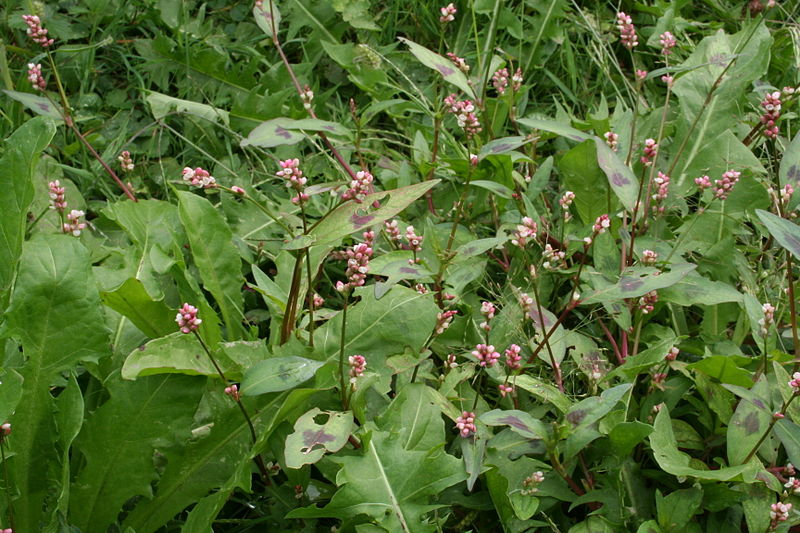
Persicaria maculosa, an edible plant with dozens of names most relating to the smudge on the leaf.
Rain, yellow jackets, Lady Thumbs, Honey Mushrooms, and Chickweed punctuated my foraging classes in South Carolina this past weekend. Before we get into the details many thanks to Lenard and Donna Putney for the use of Putney Farm for the classes and for the sponsor of Upstate Weedeaters Anonymous (of South Carolina) also on Facebook.
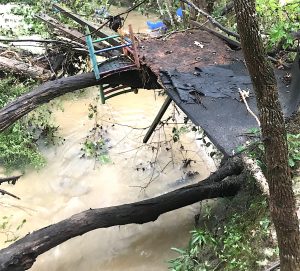
Chair in tree from flooding. Photo by Green Deane
The rain was from a front passing that came through Friday and left about 10 inches. I did get stuck at the end of the farm’s driveway but skills from decades of getting unstuck from snow and frost-heave mud kicked in and all I got was wet. Saturday it was not heavy slogging but things were a tad damp. A nearby creek flooded badly and the area we look for Ipomoea pandurata and Box Elder was too soggy to visit. How high was the water? Note the chair in the tree. A nearby fellow who built too close to the small creek also had his truck muck mired and his generator float away along with an inflatable child bounce-house.
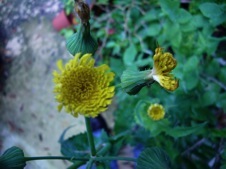
Sow thistle, in this case, Sonchus asper, is a cool weather pot herb. Photo by Green Deane
As for yellow jackets… on Saturday’s class I was fortunate enough to step directly on their ground entrance while talking about a sow thistle, Sonchus Asper. That — unknowingly — kept them at bay. We also covered Wild Geraniums as the same stop as well as Amaranth and Rumex hastatulus, a nice tart sorrel. Not one sting. Good thing as the class was a dozen or so people. By Sunday morning, however, the little stingers had dug out and I got too close though I did not know that until they strafed my leg. Fortunately I am not allergic to their stings. I did talk a little faster though….
As for the chickweed…. While scruffing some Carolina Bristle Mallow I saw a couple of one-inch high plants that looked familiar. Their raw corn taste confirmed them as chickweed (clearly starting its seasonal run in South Carolina. I don’t see them in Florida until perhaps late January or early February.) Knowing they were up we found more in select places. The Bristle Mallow, incidentally, is a semi-edible.
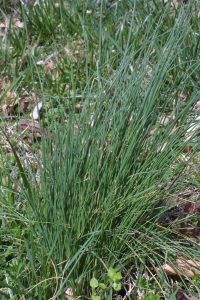
If it looks like a garlic and smells like a garlic it is edible.
Two other surprises of the weekend were a young garlic and honey mushrooms. As to which wild garlic my guess is Allium vineale, (ALL-ee-um VINE-ee-ul) also called Crow Garlic. It’s not native but rather came from Eurasia during the colonial period. The species is grass-like when young and later sends up a long seed spike with small cloves on top. If a plant looks like a garlic and smells like a garlic it is edible no matter where you are on earth. That’s also true with onions: If it looks like an onion and smells like an onion it is edible but you have to have both, looks and aroma. Here in Florida we have a toxic lily that looks like a garlic/onion but has no aroma.
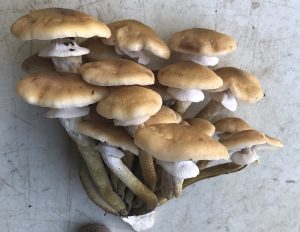
Honey Mushrooms are cespitose, growing in a clump. Photo by Green Deane
I am extremely familiar with Ringless Honey Mushrooms but this was the first time I saw Honey Mushrooms (with a ring) Armillaria mellea. Fortunately also with the class Saturday was Tom McGrath from Georgia who is familiar with the species. They are among the few mushrooms that are cespitose which means growing in a clump (think like a bouquet, large caps on top like blossoms with decreasing skinny stems down to a point that holds together.) Interestingly that area of South Carolina has both species — Honey and Ringless Honeys and are they first to respond to the cooling weather of fall. The ones in the picture came home with me.

Classes are held rain or shine or cold. (Hurricanes are an exception.) Photo by Kelly Fagan.
Foraging Classes: Less traveling this weekend for foraging classes, at least for me. Sarasota on Saturday and Winter Park on Sunday.
Saturday October 16th, Red Bug Slough Preserve, 5200 Beneva Road, Sarasota, FL,. 9 a.m. to noon.
Sunday October 17th, Mead Garden: 1500 S. Denning Dr., Winter Park, FL 32789. Meet at the bathrooms. 9 a.m. to noon.
Saturday October 23rd, Dreher Park, 1200 Southern Blvd., West Palm Beach, 33405. 9 a.m. to noon, meet just north of the science center.
Sunday October 24th, Bayshore Live Oak Park, Bayshore Drive. Port Charlotte. 9 a.m. to noon, meet at the parking lot of Bayshore and Ganyard.
For more information, to pre-pay or sign up go here.
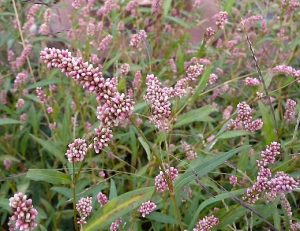
Lady Thumbs are distantly related to Japanese Knotweed.
Pretty easy to see during our classes but hard to sort out were the prolific Lady Thumbs, Persicaria maculosa. Botanists are of little help here. The plant (and relatives) have bounced between to genera — Polygonum and Persicaria — and have had multiple names, botanical and common. Fortunately there are no known toxic plants in the greater group if you don’t get the ID down to the species. They are usually mild when young and can be peppery when older. The plants are usually used in salads, more when mild, as a spice when peppery though they can be a pot herb as well. In a raw serving there is some B2, vitamin C and vitamin A. When cooked only B2 was detected. Persicaria maculosa (as of this writing) is a native of Eurasia and is on the weed hit list of many states. There are a couple of native species that can resemble it: The Nodding Smartweed (Persicaria lapathifolia) and Pennyslvania Smartweed (P. pensylvania.)

Green Deane videos are now available on a USB.
My nine-DVD set of 135 videos has been phased out and replaced by a 150-video USB. The USB videos are the same videos I have on You Tube. Some people like to have their own copy. The USB videos have to be copied to your computer to play. If you want to order the USB go to the DVD/USB order button on the top right of this page or click here. That will take you to an order form. I’d like to thank all of you who ordered the DVD set over the years which required me to burn over 5,000 DVDs individually.

Green Deane Forum
Want to identify a plant? Perhaps you’re looking for a foraging reference? You might have a UFO, an Unidentified Flowering Object, you want identified. On the Green Deane Forum we — including Green Deane and others from around the world — chat about foraging all year. And it’s not just about warm-weather plants or just North American flora. Many nations share common weeds so there’s a lot to talk. There’s also more than weeds. The reference section has information for foraging around the world. There are also articles on food preservation, and forgotten skills from making bows to fermenting food.
This is my weekly free newsletter #477. If you want to subscribe to this free newsletter you can find the sign-up form in the menu at the top of the page.
To donate to the Green Deane Newsletter click here.


honeys prevalent here , berkshire county , ma. gathering sildene vulgaris, aka bladder campion. as wellas wood sorrel. Great read Dean